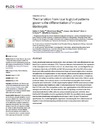Identificador persistente para citar o vincular este elemento:
https://accedacris.ulpgc.es/jspui/handle/10553/73883
| Título: | The transition from local to global patterns governs the differentiation of mouse blastocysts | Autores/as: | Fischer, Sabine C. Corujo-Simon, Elena Lilao Garzón, Joaquín Stelzer, Ernst H.K. Muñoz Descalzo, Silvia |
Coordinadores/as, Directores/as o Editores/as: | Kelly, Gregory M. | Clasificación UNESCO: | 32 Ciencias médicas 320102 Genética clínica 2407 Biología celular 240901 Embriología |
Palabras clave: | Embrylogy Blastocyst Mice Transcripction factors Endoderm, et al. |
Fecha de publicación: | 2020 | Publicación seriada: | PLoS ONE | Resumen: | During mammalian blastocyst development, inner cell mass (ICM) cells differentiate into epiblast (Epi) or primitive endoderm (PrE). These two fates are characterized by the expression of the transcription factors NANOG and GATA6, respectively. Here, we investigate the spatio-temporal distribution of NANOG and GATA6 expressing cells in the ICM of the mouse blastocysts with quantitative three-dimensional single cell-based neighbourhood analyses. We define the cell neighbourhood by local features, which include the expression levels of both fate markers expressed in each cell and its neighbours, and the number of neighbouring cells. We further include the position of a cell relative to the centre of the ICM as a global positional feature. Our analyses reveal a local three-dimensional pattern that is already present in early blastocysts: 1) Cells expressing the highest NANOG levels are surrounded by approximately nine neighbours, while 2) cells expressing GATA6 cluster according to their GATA6 levels. This local pattern evolves into a global pattern in the ICM that starts to emerge in mid blastocysts. We show that FGF/MAPK signalling is involved in the three-dimensional distribution of the cells and, using a mutant background, we further show that the GATA6 neighbourhood is regulated by NANOG. Our quantitative study suggests that the three-dimensional cell neighbourhood plays a role in Epi and PrE precursor specification. Our results highlight the importance of analysing the three-dimensional cell neighbourhood while investigating cell fate decisions during early mouse embryonic development. | URI: | https://accedacris.ulpgc.es/handle/10553/73883 | ISSN: | 1932-6203 | DOI: | 10.1371/journal.pone.0233030 | Fuente: | PLoS ONE [EISSN 1932-6203], v. 15 (5), e0233030 (Mayo 2020) |
| Colección: | Artículos |
Citas SCOPUSTM
16
actualizado el 08-jun-2025
Citas de WEB OF SCIENCETM
Citations
17
actualizado el 08-jun-2025
Visitas
144
actualizado el 14-dic-2024
Descargas
134
actualizado el 14-dic-2024
Google ScholarTM
Verifica
Altmetric
Comparte
Exporta metadatos
Los elementos en ULPGC accedaCRIS están protegidos por derechos de autor con todos los derechos reservados, a menos que se indique lo contrario.
